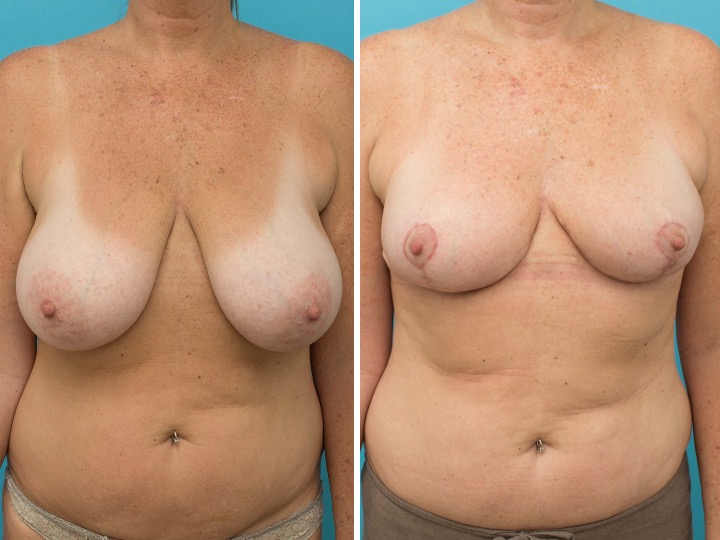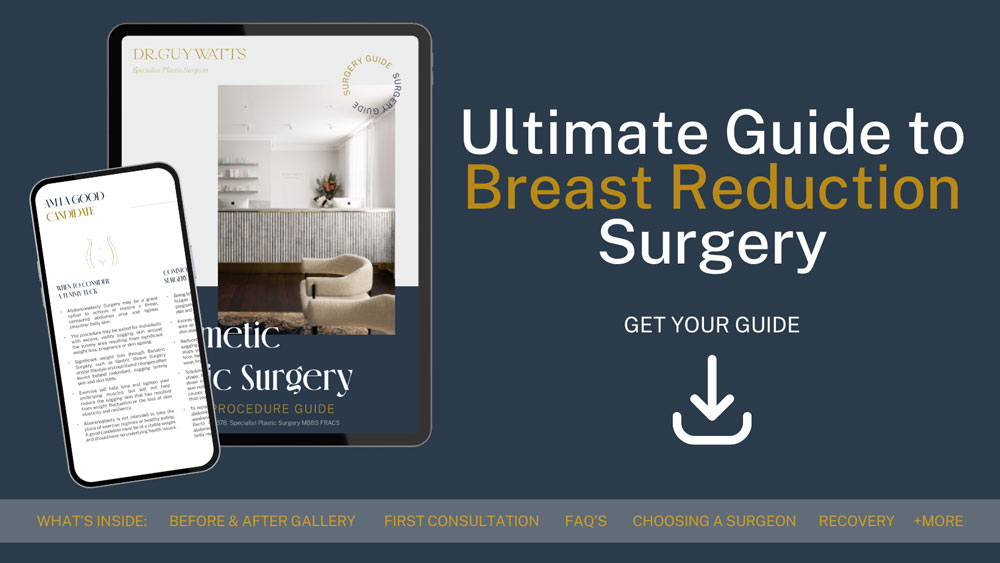
21 Sep Exercising after Breast Reduction
What Exercises to Try and When to Start Exercising after Breast Reduction
After going through the Breast Reduction surgery, you may be eager to return to your regular activities, including exercise. However, it’s essential to approach this transition carefully. The importance of exercise after Breast Reduction surgery extends far beyond the realm of physical fitness.
Exercise plays a multifaceted role in your post-surgery life, serving as a crucial component in your recovery journey. One of the potential benefits of engaging in appropriate physical activity is increased blood circulation. Good circulation is vital for wound healing and can help reduce the risk of post-operative complications like blood clots or infections.
Plastic Surgeon Dr. Guy Watts will provide you with instructions regarding exercises after Breast Reduction surgery.
Take our quiz, and find out if you are ready for surgery
Recovery after Breast Reduction Surgery
After your surgery, to manage your expectations and plan your return to exercise, it’s key to understand the phases your body will go through after the procedure.
What Happens Immediately After Surgery
Right after your surgery, you will likely experience discomfort and limited mobility. You’ll need to wear a post-surgical bra and possibly a compression garment to support the healing process.
The initial stage is primarily focused on pain management and wound care. Exercise is generally off-limits during this period to avoid any complications.
Stages of Recovery
The recovery process can be broadly divided into three stages:
- Week 1-2: This is the immediate post-op stage where rest is the main focus.
- Week 3-6: At this point, Dr. Guy Watts may allow light exercises, such as walking and light stretches.
- Week 6 onwards: If you’re healing well, this is when your surgeon may give you the green light to engage in more strenuous exercises.
DOWNLOAD DR WATTS’ GUIDE TO BREAST REDUCTION

Signs Your Body Is Ready for Exercise
Below are some indicators to watch for:
Reduced Pain and Discomfort
- Feeling More Comfortable: One of the first signs that you’re ready to start exercising again is a noticeable reduction in pain and discomfort. In the days immediately following your surgery, even basic movements can be painful. As you heal, you’ll find that this discomfort starts to reduce.
- Less Reliance on Pain Medication: If you find that you’re not reaching for over-the-counter pain relievers as often, this could be a sign that your body is healing well. However, always consult Dr Watts before making any changes to your medication schedule.
- Ability to Perform Daily Activities: When you can go about your daily tasks—like showering, dressing, and cooking—without significant pain, it’s a good indicator that you might be ready for light exercise.
Increased Range of Motion
- Easier Movement: As you recover, you’ll likely notice that your range of motion starts to increase. You might find it easier to reach for items on high shelves or to perform tasks that require more arm movement
- Stretching Becomes Easier: If you can stretch your arms and upper body without feeling tightness or pulling around your surgical area, it’s a positive sign. However, always start with careful stretches and avoid anything that feels like a strain
- No Pulling Sensation: A pulling sensation around the surgical area is common in the initial stages of recovery. An absence of this feeling when moving can indicate that your body is ready for more activity
Reduced Swelling and Inflammation
- Visual Inspection: One of the most straightforward ways to gauge reduced swelling is by looking at the surgical area. If the swelling has gone down noticeably, it’s a good sign.
- Less Tightness: Swelling can make the skin around your surgical area feel tight. A reduction in this tightness can indicate that the swelling is dissipating.
- Clothing Fit: You might notice that your clothing starts to fit more comfortably around your chest area. This can be another indicator that the swelling is reducing.
It’s vital to listen to your body and not rush this process. The timelines mentioned are general guidelines, and individual recovery can vary.
Early Post-Surgery Exercises
Once you’ve moved past the initial stages of recovery and have the go-ahead from Dr Guy, it’s time to gently reintroduce exercise into your daily routine. It’s important to start light to reduce risks while aiding your body’s healing process. Here are some low-impact exercises that can help you ease back into an active lifestyle.
1. Breathing Exercises
Breathing exercises are an excellent starting point in your post-surgery exercise journey. They have numerous advantages, all while posing little to no strain on your surgical site.
- Relaxation: Breathing techniques can relax your muscles, helping to reduce post-surgical tension and stress.
- Increased Circulation: Deep breathing can help increase your blood circulation, which is essential for healing.
- Lung Capacity: These exercises can also help increase your lung capacity, making future exercises easier and more efficient.
How to Perform Breathing Exercises:
- Inhale Deeply: Take a deep breath in through your nose, aiming to fill your lungs completely. Count to three while inhaling.
- Hold Your Breath: Once you’ve inhaled, hold your breath for another count of three.
- Exhale: Slowly breathe out through your mouth, emptying your lungs entirely. Again, use a count of three for this step.
- Pause: Before taking another breath, pause for a count of three.
Repeat this cycle five to ten times, focusing on your breath. You can perform this exercise multiple times throughout the day.
2. Range-of-Motion Exercises
As you progress in your healing, increasing your full range of motion becomes a priority. Basic stretching and movement exercises can help in achieving this goal.
Arm Circles: This exercise helps with shoulder and upper-arm mobility
- Start with small circles and gradually make them larger
- Perform 10 circles in each direction
Wrist Flexes: This will help increase the flexibility in your wrists and forearms
- Flex your wrist upwards and then downwards
- Hold each position for 15-20 seconds
Shoulder Shrugs: Great option for relieving tension and increasing shoulder mobility
- Raise your shoulders towards your ears
- Hold for a few seconds and release
Safety Tips:
- Always perform these exercises in a slow and controlled manner
- If any movement causes discomfort or pain, stop immediately
You can do these exercises two to three times a day, but remember, always consult Dr Watts or physical therapist for personalised advice.
3. Walking and Light Movement
Walking is one of the fundamental ways to reintroduce physical activity into your routine. It doesn’t put too much strain on your upper body and can be adapted to your comfort level.
- Indoor Walking: Initially, consider walking indoors where the terrain is even, and you can stop and rest.
- Time and Distance: Start with short intervals (say 5 minutes) and then gradually increase as you feel more comfortable.
- Pace: Keep your pace light to start with. There’s no need to push yourself too hard.
Considerations While Walking:
- Footwear: Choose comfortable and supportive shoes to help you walk as smooth as possible.
- Posture: Maintain an upright posture, keeping your back straight and your arms relaxed.
- Hydration: Don’t forget to keep a bottle of water handy, especially if you plan on walking for longer periods.
You can begin with an uncomplicated 5 to 10-minute walk around your home, gradually extending the time and perhaps venturing a bit further as you grow more comfortable. The key is to listen to your body and make adjustments as needed.
Intermediate Exercises to Consider
Once you can do the basic exercises and have the okay from Dr Guy, you may start with more challenging activities. It’s important to approach this next phase of your exercise journey with caution, always paying attention to your body’s signals.
Below are some intermediate exercise categories to consider incorporating into your routine.
4. Strength Training
Strength training is an excellent way to build muscle mass and increase your overall physical capability. However, when it comes to post-surgical exercise, you’ll need to be mindful of not overstraining your upper body.
Leg Squats: This exercise focuses on your lower body, keeping strain away from your chest
- Stand with feet shoulder-width apart
- Bend at the knees to lower yourself
- Keep your back straight
- Return to the starting position
Resistance Bands: Utilising resistance bands can help strengthen different muscle groups. You can perform bicep curls and leg extensions as well as a range of other exercises. You can start with lighter resistance and work your way up.
Lunges: Another lower-body exercise that keeps the strain away from the upper body
- Step forward with one foot
- Lower your body until both knees are bent at a 90-degree angle
- Push back up to the starting position
Safety Guidelines:
- Use light weights initially, gradually increasing as you become more comfortable and stronger.
5. Cardiovascular Activities
Cardiovascular exercise is essential for heart health and can help you maintain a stable weight. However, it’s important to choose activities that won’t put stress on your upper body.
Cycling: Stationary bikes or outdoor cycling are good options
- Keep the resistance low to start
- Maintain a moderate pace
Jogging: If you’re a fan of jogging, begin with a slow pace
- Keep distances short at first
- Opt for even, flat terrain to reduce impact
Swimming: This could be an option later in your recovery, but only after your surgical wounds are fully healed and you have approval from your plastic surgeon
Cardio Guidelines:
- Avoid high-impact activities like jumping jacks or running at high speeds
- Limit your sessions to short intervals, gradually increasing as you gain more endurance
6. Core Strengthening
Strengthening your core muscles can have a positive impact on your overall fitness. This can be achieved without putting stress on your chest area.
Planking: A straightforward yet effective core exercise
- Start with short intervals, such as 10 to 15 seconds
- Keep your body in a straight line from head to heels
Pilates: This low-impact exercise program focuses on core strength
- Opt for beginner classes/routines initially
- Use props like a Pilates ball for added support
Yoga: Certain yoga poses focus on core strength
- Choose poses that don’t require arm strength or upper body tension
Core Exercise Tips:
- Keep your movements slow and controlled
- Take breaks if you feel any strain or discomfort
Dos and Don’ts
Navigating the path back to exercise after Breast Reduction surgery can be a bit tricky. It’s important to know what you should and shouldn’t do. Below is a look at the dos and don’ts.
What to Avoid – DON’TS
- High-Impact Activities
- Exercises like running, jumping, or any form of high-impact aerobics can be too much for your body to handle in the early stages of recovery.
- These activities can put a lot of stress on your surgical area and may lead to complications.
- Heavy Lifting
- Whether it’s at the gym or around the house, lifting heavy objects is a no-go in the initial weeks after surgery.
- They can strain your upper body and potentially disrupt the healing process.
- Overstretching
- While it’s good to maintain some level of flexibility, be cautious not to overstretch, especially around the surgical area.
- Overstretching can lead to pain and may even damage the healing tissues.
- Ignoring Pain
- If you experience pain while exercising, it’s a sign that you may be pushing your body too hard.
- Pain is your body’s way of telling you to slow down, so listen to it.
- Skipping Rest Days
- Your body needs time to heal, especially after surgery.
- Don’t skip rest days in an attempt to speed up your fitness progress.
- Rest is just as important as exercise in your recovery journey
What to Do
- Walking
- This is one of the most beginner-friendly forms of exercise you can do after surgery.
- It’s low-impact and helps increase blood circulation, aiding in the healing process.
- Breathing Exercises
- Deep breathing can help increase lung capacity and help oxygenate your blood, which is good for healing.
- Basic breathing exercises can be done even when you’re lying down or sitting.
- Light Cardio
- Once you get the all-clear from your healthcare provider, light cardio exercises like cycling on a stationary bike can be good for your heart and overall well-being.
- Hydration
- Staying hydrated is essential, especially when you start exercising. Proper hydration can help flush out toxins and keep your body functioning as it should.
- Nutrition
- Eating a balanced diet rich in protein, vitamins, and minerals can aid recovery and provide you with the energy you need.
- Listen to Your Body
- Always pay attention to how your body responds during and after exercise.
- If you feel good and don’t experience any discomfort, you can gradually increase the intensity of your workouts, but always under medical guidance.
FAQs about Exercise after Breast Reduction
When is it alright to start exercising after Breast Reduction surgery?
- Generally, light exercise like walking can be started shortly after surgery. However, the exact timing can vary from person to person.
- It’s essential to consult your Dr. Watts for personalised advice tailored to your specific recovery status.
What types of exercises are recommended in the initial stages of recovery?
- Low-impact exercises such as walking and deep breathing exercises are usually recommended in the initial stages.
- These exercises do not strain the body and can aid in the healing process without putting pressure or strain on the surgical area.
Can I do cardio and strength training after Breast Reduction?
- Yes, but it’s important to wait until you’ve received the all-clear from your plastic surgeon.
- Light cardio like cycling on a stationary bike can be introduced first, followed by strength training exercises.
- Always start with lighter weights and work your way up, under medical guidance.
How can I monitor my progress and know if I’m overdoing it?
- Keeping a log of your exercises can help you track your progress.
- Listen to your body; if you experience pain, fatigue, or any unusual symptoms, it’s a sign that you may be pushing yourself too hard.
What should I do if I experience pain or discomfort while exercising?
- If you experience pain or discomfort, stop the exercise immediately and consult your plastic surgeon.
- Pain is a sign that something may be wrong, and it’s important to get medical advice to rule out any complications.
Further Reading about Breast Surgery with Dr. Watts
- Read Dr. Watts’ Blog about How to Sleep After Cosmetic Breast Surgery
- Read Dr Watts’ Blog about How to Reduce Bruising after Breast Reduction
- Read Dr. Watts’ Blog about Surgical Options to Get Firmer Breasts
- Read Dr. Watts’ Blog about What causes Breasts to drop– Causes and Surgery for Breast Ptosis
- Read Dr. Watts’ Blog about Top 10 Methods to Reduce Scars after Breast Reduction Surgery
- Read Dr. Watts’ Blog about Will Medicare Cover my Breast Reduction?
- Read Dr. Watts’ Blog about Options for Heavy Breasts – Breast Reduction
- Read Dr. Watt’s Blog about What are Expected Symptoms to Experience During Breast Reduction Recovery
- Read Dr Watts’ Blog about How to Choose the Compression Garments after Breast Reduction
- Read Dr. Watts’ Breast Reduction Surgery Page
- Read Dr. Watts’ Breast Lift Surgery Page
Medical References about Exercise after Breast Reduction
About Dr. Guy Watts – MED0001539378
FRACS (Plas) – Specialist Plastic Surgeon In Perth WA
Dr. Guy Watts is a Specialist Plastic Surgeon (AHPRA MED0001539378) with an extensive career that spans across renowned plastic surgery clinics worldwide. His experience has been honed through invaluable experiences at esteemed establishments such as the New York Eye and Ear Infirmary and the renowned Pitanguy Clinic in Brazil.
Having collaborated with the foremost cosmetic plastic surgeons on a global scale, Dr. Watts has chosen to return to Perth after a 17-year journey of intensive training and invaluable professional experience to bring the latest practices and technology in cosmetic plastic surgery to his patients.
Dr. Watts is a Fellow of the Royal Australasian College of Surgeons (FRACS) and a Member of the Australian Society of Plastic Surgeons (ASPS), Australasian Society of Aesthetic Plastic Surgeons (ASAPS) and the International Society of Aesthetic Plastic Surgeons (ISAPS).
Read about the potential Risks and Complications of Surgery
Read the Patient Information and Resources
About CLINISPA
Clinispa is Dr Watts’ bespoke medical clinic performing Cosmetic Aesthetic treatments. At Clinispa, we offer advanced clinical treatments in a luxurious and calming environment, tailored to support your skin’s health and appearance.
Clinispa aesthetic services are performed by Dr Guy Watts’ nursing professionals, who have a passion for and solid understanding of facial aesthetics.
All Clinispa clients are considered individually, with a personalised treatment plan consisting of advanced scientific approaches to cosmetic aesthetics. We incorporate innovative technologies in conjunction with superiorly formulated skin care.
For more information about the full range of Clinispa Aesthetic of Cosmetic Treatments visit the Clinispa website








Sorry, the comment form is closed at this time.